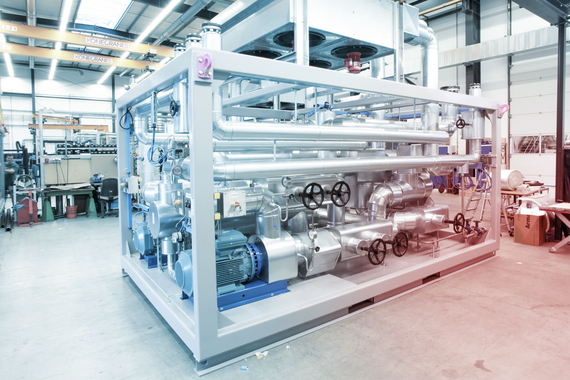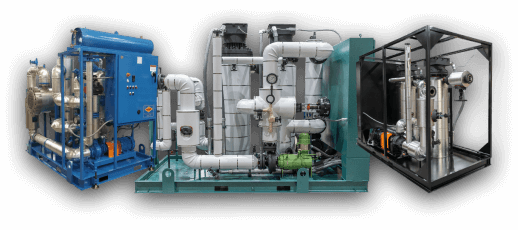Can DVS Heat Transfer Systems Designed for High-Performance Electronics Cooling?
Exploring the Conveniences and Applications of Heat Transfer Solutions in Modern Sector
Heat transfer systems play a necessary function in modern sector. They encompass different mechanisms such as transmission, convection, and radiation, each contributing to reliable thermal administration. Industries like manufacturing and aerospace benefit considerably from these systems. As advancements continue, the assimilation of innovative products and innovations assures to enhance power performance. This evolution raises essential concerns regarding the future ramifications for sustainability and functional expenses throughout multiple markets. What exists in advance in this recurring change?
Recognizing Heat Transfer Principles
Heat transfer concepts are basic to the operation of various industrial systems. These principles include the systems of conduction, radiation, and convection, each playing an important duty in managing thermal energy. Comprehending conduction involves analyzing exactly how Heat moves via solid products, while convection pertains to Heat transfer in fluids, driven by liquid movement. Radiation, unique from the various other 2, involves power transfer with electro-magnetic waves. The efficiency of Heat transfer effects system efficiency, energy intake, and total productivity. Efficient thermal monitoring is important in procedures such as heating, Heat, and air conditioning recovery. By grasping these principles, sectors can enhance their procedures, minimize power expenses, and boost equipment durability, thus adding to an extra sustainable and reliable commercial landscape.
Trick Types of Heat Transfer Equipments
While different sectors make use of Heat transfer systems for varied applications, numerous key kinds stand out as a result of their particular functions and effectiveness. The most common types consist of convection, radiation, and conduction systems. Transmission systems transfer Heat with straight contact in between products, making them efficient in solid-state applications. Convection systems, on the various other hand, utilize fluid movement to transfer Heat, ideal for home heating or cooling down gases and fluids. Radiation systems run without a tool, depending on electro-magnetic waves to move Heat, suitable for high-temperature settings. Each type offers distinct purposes, permitting industries to customize their Heat transfer services based upon operational needs, energy efficiency, and cost-effectiveness. Recognizing these systems is vital for optimizing efficiency in numerous industrial settings.
Industrial Applications of Heat Transfer Technologies
The application of Heat transfer innovations in sector plays a crucial role in improving energy effectiveness and enhancing processes. DVS Heat Transfer Systems. By applying advanced Heat exchange systems, business can considerably decrease their ecological effect while improving overall productivity. This integration not just promotes sustainability yet likewise aligns with modern-day regulatory and consumer needs for greener practices
Power Efficiency Improvements
As markets increasingly focus on sustainability, power performance enhancements in Heat transfer innovations have actually become crucial for minimizing functional expenses and ecological effect. Boosted Heat exchangers, for example, make use of advanced products and layouts to make the most of thermal efficiency while reducing power intake. Integrating variable speed drives in pumping systems permits for better control of fluid circulation, leading to substantial energy financial savings. The execution of wise sensing units and automation provides real-time monitoring, enabling adjustments that optimize energy use. Additionally, waste Heat recovery systems catch excess thermal power, transforming it into usable power. These improvements not just boost power effectiveness yet likewise add to a much more lasting commercial landscape by decreasing greenhouse gas emissions and sustaining conformity with environmental guidelines.
Process Optimization Techniques
Process optimization methods are crucial in improving the effectiveness and effectiveness of Heat transfer innovations in industrial applications. These techniques involve refining procedures to optimize Heat transfer efficiency while reducing power intake and functional prices. Approaches such as computational fluid dynamics (CFD) modeling permit designers to assess and replicate Heat transfer scenarios, identifying locations for improvement. Additionally, real-time monitoring systems can give beneficial data on temperature slopes and circulation rates, enabling changes that maximize performance. Carrying out innovative control methods, such as predictive analytics, can boost system responsiveness to varying operational needs. By applying these optimization strategies, markets can achieve higher thermal performance, minimized downtime, and improved item quality, inevitably causing increased competition in the market.

Environmental Influence Reduction
While commercial Heat transfer modern technologies are necessary for operational effectiveness, their application likewise provides chances for considerable environmental effect reduction. By enhancing power performance, these systems decrease fuel intake, resulting in reduced greenhouse gas emissions. For example, progressed Heat exchangers can recoup waste Heat, redirecting it to preheat inbound liquids, thereby decreasing energy needs. Additionally, the integration of Heat transfer modern technologies in renewable resource systems, such as solar thermal and geothermal applications, sustains the shift to sustainable methods. Industries that employ these innovations likewise take advantage of lowered functional costs and enhanced regulative conformity. On the whole, the critical implementation of Heat transfer systems not only strengthens performance but also fosters a more sustainable industrial landscape, contributing to global environmental objectives.
Benefits of Reliable Heat Transfer Equipments
Reliable Heat transfer systems provide significant advantages in contemporary industry, largely with enhanced power efficiency and cost reduction. By maximizing thermal monitoring, these systems decrease power waste, bring about reduced operational costs (DVS Heat Transfer Systems). Companies can achieve better sustainability and enhanced success.

Energy Performance Improvements
As markets significantly prioritize sustainability and cost-effectiveness, energy effectiveness enhancements in Heat transfer systems have actually become a critical focus. Improved effectiveness in these systems results in decreased energy usage, enabling facilities to run more sustainably. By enhancing Heat transfer techniques, sectors can minimize waste Heat and achieve better thermal administration, substantially lowering their ecological influence. Breakthroughs in modern technologies such as Heat exchangers and insulation materials add to boosted efficiency and integrity. Furthermore, implementing energy-efficient Heat transfer remedies not just supports compliance with regulatory criteria but additionally promotes a culture of innovation within companies. Ultimately, these renovations are crucial in straightening industrial procedures with worldwide energy preservation goals, leading the way helpful resources for a much more sustainable future in manufacturing and handling markets.
Cost Decrease Opportunities
By enhancing Heat transfer systems, sectors can expose significant price reduction possibilities that improve their bottom line. Effective Heat transfer lowers power consumption, causing lower energy bills and decreasing operational expenditures. Additionally, improved system efficiency lowers the demand for upkeep and repair work, furthermore saving expenses gradually. Enhanced Heat transfer can likewise expand equipment life-span, allowing firms to delay capital investment on replacements. Waste Heat recovery systems can transform excess Heat into functional power, better driving down costs. These systems not only simplify processes however also add to sustainability efforts, placing firms positively in a significantly eco-conscious market. In general, the financial benefits of effective Heat transfer systems are considerable and essential for competitive benefit.
Developments in Heat Transfer Solutions
Exactly how can modern market improve its operations through ingenious Heat transfer services? By embracing sophisticated products and technologies, industries can significantly improve thermal effectiveness and efficiency. Developments such as nanofluids, which boost Heat transfer capacities past standard liquids, and stage adjustment products that save and release thermal power, are obtaining grip. Furthermore, the combination of wise sensors and IoT devices permits real-time surveillance and optimization of Heat transfer processes, decreasing waste and improving system responsiveness. Furthermore, additive manufacturing strategies make it possible for the development of more complex Heat exchangers that optimize surface while minimizing product use. Jointly, these developments drive operational performance and develop affordable benefits in numerous industries, including production, energy, and aerospace.
The Role of Heat Transfer in Sustainability Initiatives
While the promote sustainability continues to reshape industries, the role of Heat transfer innovations becomes progressively necessary in attaining environmental objectives. Effective Heat transfer systems facilitate power efficiency by maximizing thermal monitoring in different processes, significantly reducing energy intake and greenhouse gas emissions. Progressed Heat exchangers are utilized in commercial applications to reclaim waste Heat, therefore minimizing Full Article energy waste. In addition, innovations such as phase adjustment products enhance thermal storage, adding to renewable energy integration. In addition, the fostering of lasting fluids in Heat transfer systems can minimize ecological influence. By focusing on reliable Heat transfer, industries not only boost functional performance however additionally straighten with global sustainability initiatives, fostering a cleaner, much more sustainable future.
Often Asked Concerns
Exactly How Do Heat Transfer Systems Impact Energy Costs in Production?
Heat transfer systems substantially affect power prices in production by enhancing efficiency, decreasing waste, and maximizing thermal administration. These enhancements cause reduce operational expenses, ultimately benefiting total performance and earnings in commercial operations.
What Maintenance Is Needed for Heat Transfer Systems?
Maintenance for Heat transfer systems includes routine assessments, cleaning of elements, checking fluid degrees and problems, changing used parts, and guaranteeing proper insulation. These activities boost effectiveness, extend lifespan, and avoid expensive breakdowns in procedure.
Exist Security Worry About Heat Transfer Systems?
Safety issues with Heat transfer systems consist of possible leakages, pressure accumulation, and thermal risks. Correct design, normal maintenance, and adherence to safety protocols are necessary to reduce these threats and ensure secure operation in industrial settings.
How Can I Choose the Right Heat Transfer System for My Business?
Choosing the best Heat transfer system entails evaluating variables such as effectiveness, application requirements, budget plan constraints, and safety criteria. A comprehensive evaluation of these elements will certainly assist assure ideal performance and dependability in service procedures.
What Are Usual Failures in Heat Transfer Systems and Their Causes?

Understanding conduction includes analyzing exactly how Heat relocates through strong products, while convection pertains to Heat transfer in liquids, driven by liquid motion. By enhancing Heat transfer methods, markets can minimize waste Heat and achieve better thermal administration, greatly reducing their ecological influence. Waste Heat recovery systems can transform excess Heat into functional power, further driving down costs. Progressed Heat exchangers are made use of in industrial applications to reclaim waste Heat, thus lessening power waste. Usual failings in Heat transfer systems consist of leaks, rust, and inefficient Heat exchange.